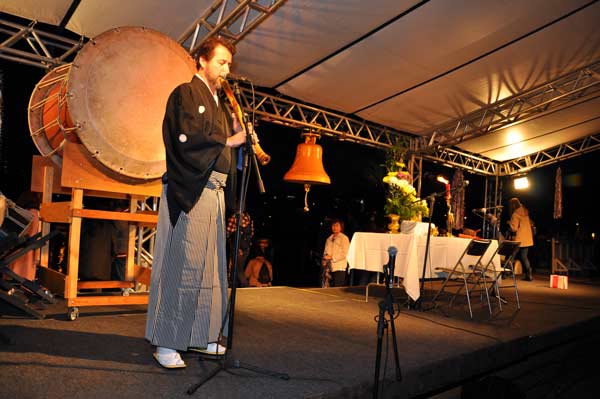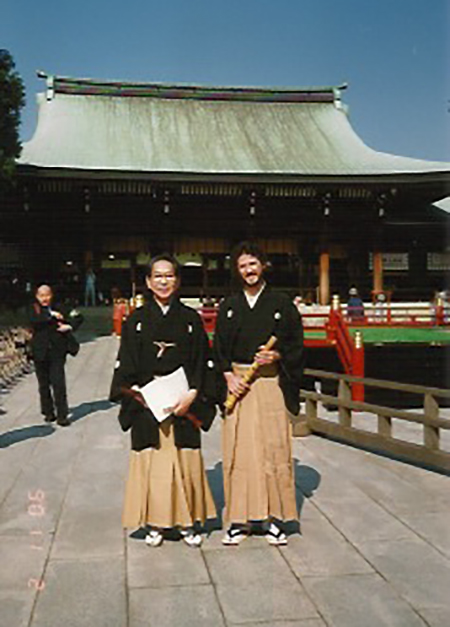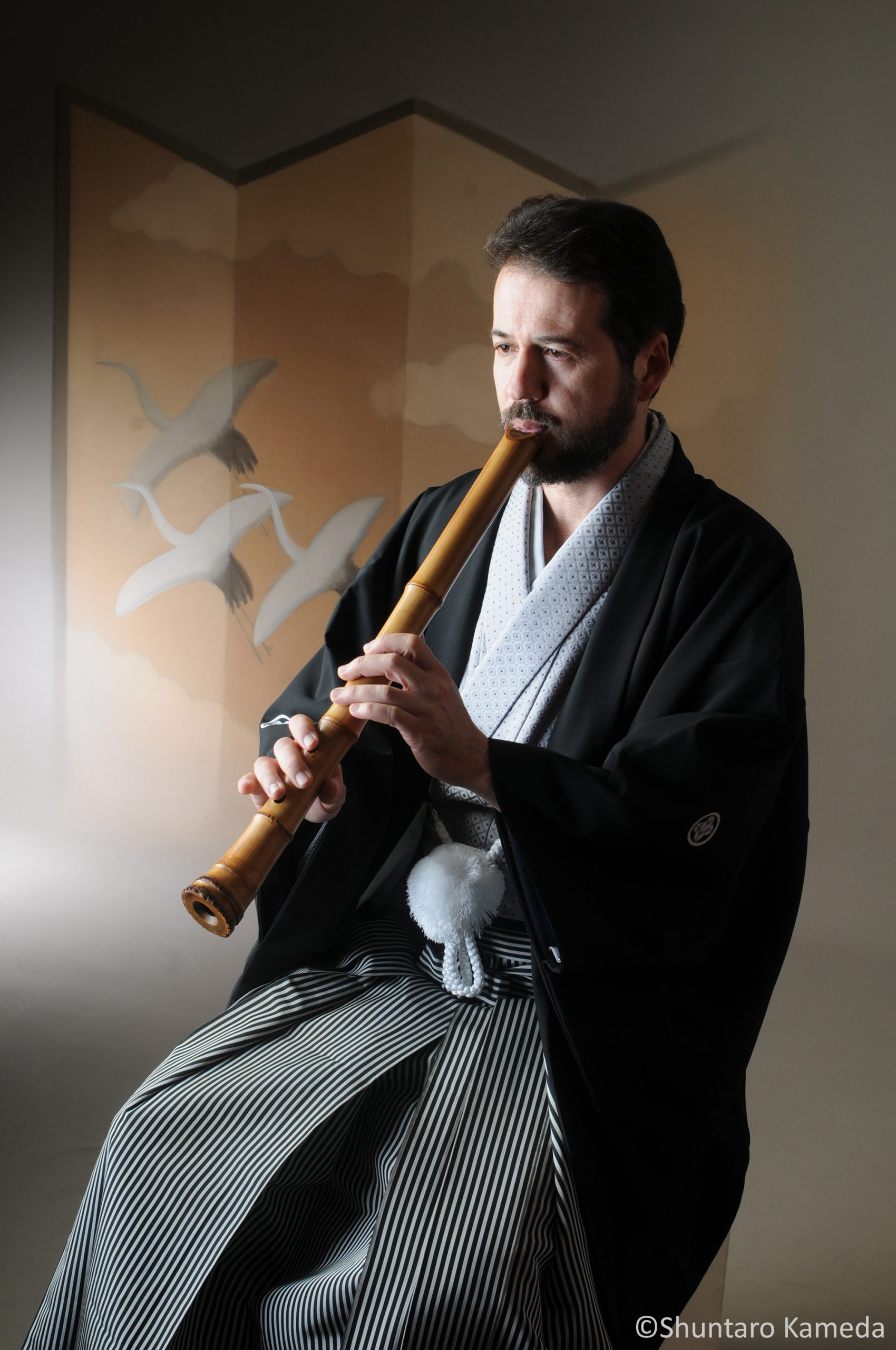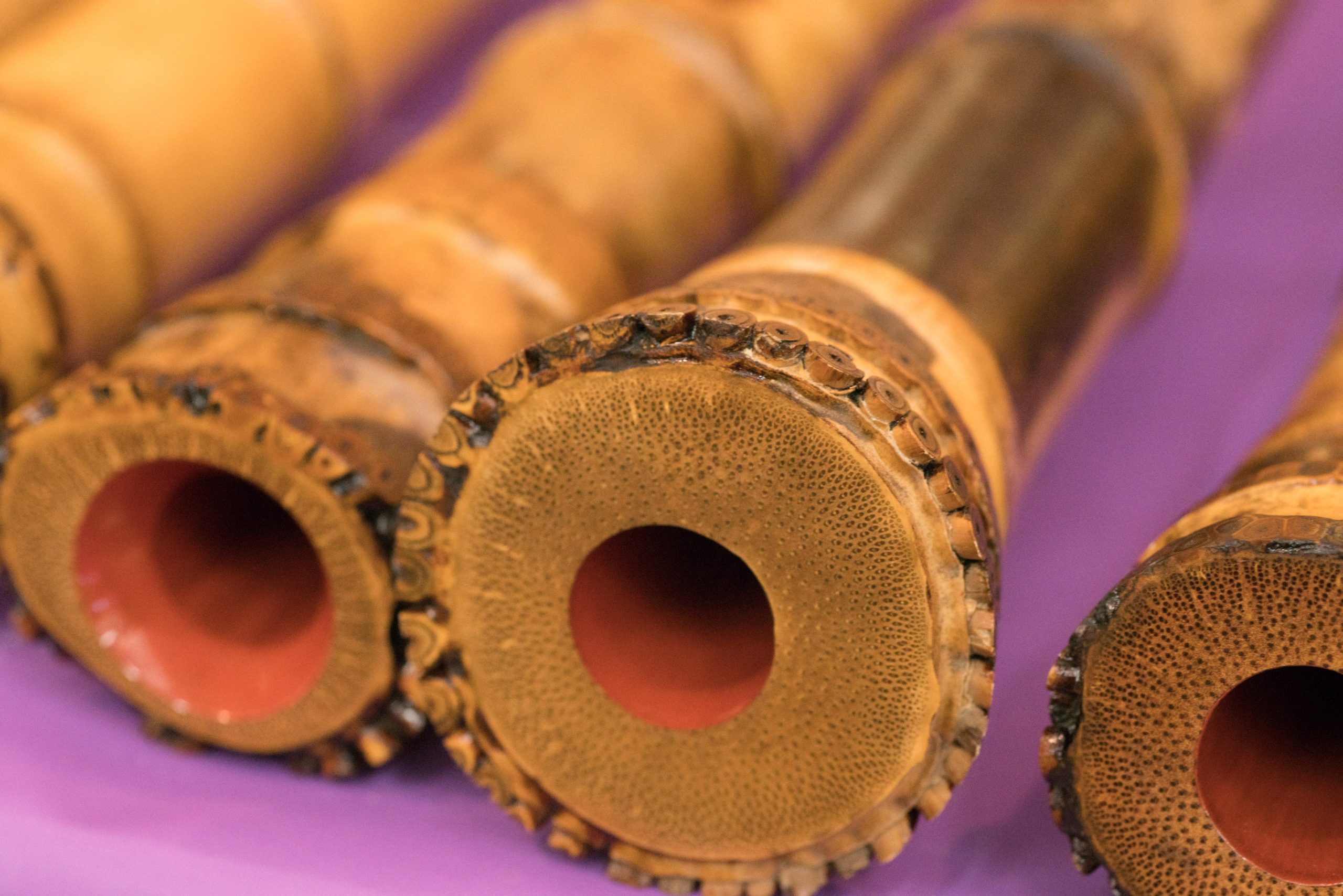Shen Kyomei Ribeiro (Shakuhachi/Flute)
Português | 日本語 | Español
Our tenth and last concert in the Music in the Castle series will be dedicated to the “shakuhachi”, a traditional Japanese bamboo flute, and to the transversal flute, performed by teacher Shen Kyomei Ribeiro.

The flute is one of the oldest instruments that we have news of. The first flutes resembled whistles, as they only had one hole and were made of bones.
In cave paintings, it is possible to observe drawings of flutes and whistles, proving the presence of this instrument since 60,000 BC. The oldest instrument ever found is a kind of flute made out of a fragment of the femur of a young cave bear, with two to four holes, found in Divje Babe in Slovenia, and is about 43,000 years old.
In 2008, another flute manufactured at least 35,000 years ago, was discovered in the Hohle Fels cave near Ulm, in Germany. The 5-hole flute has a V-shaped mouthpiece and is made from a vulture wing bone. The discovery is also the oldest confirmed for any musical instrument in history.
The flutes found in the Hohle Fels cave suggested that “the findings demonstrate the presence of a well-established musical tradition at the time modern humans colonized Europe”. Scientists have also suggested that the discovery of the flute may help explain the likely behavior and cognitive gap between the Neanderthals and the first modern humans.
Like all primitive musical instruments, the flute played a magical role, and was used to accompany religious rituals. In Vedic culture, Krishna (God) is described as a master flutist. Some cultures have banned the use of flutes by children and women, under pain of death. We still have an example of this today, in the Xingu National Park in Brazil.
The flute is a wind musical instrument, made of different types of wood and bamboo, shaped like a hollow tube with holes. It is an aerophone which, through the air flow directed to an edge that vibrates with the passage of air, emits sound. Very old, the execution of such an instrument consists of blowing the inside of the tube while the holes are being covered or uncovered with the fingers, and the person who plays the flute is called a flutist.
In 1832, the German inventor Theobald Boehm invented the modern transverse flute system, with the introduction of keys to the instrument (which is also used in various wind instruments, such as the saxophone, clarinet, and oboe, for example).
In this concert, we have two flutes that use this system: the flute in C and the flute in G.
The flute is the most versatile of wind instruments. From traditional, medieval music to jazz, going through the folk melodies of several countries, in Brazil, in rhythms such as the baião, choro, samba, bossa nova, among others. It has always been widely used in progressive rock, along with traditional instruments, bass, guitar, drums and keyboard, showing all its ability to dialog with different musical genres.
There are many types of flutes in different countries and regions, such as:

Transverse flute
Executed in a horizontal position, with a side blow, it can be made of wood or metal. Widely used in symphonic orchestras.
Vertical flute
It is blown into its upper end.
Piccolo
As its name suggests (“small” in Italian), it is a small flute, tuned one octave above the normal C flute.
Basque flute
A vertical flute, also known as flute Provençale, is a three-hole flute or galoubet.
Pan flute
Originating from Greek mythology, the pan flute is an old wind instrument, formed by a number of tubes of decreasing length. Depending on where they are built, the flutes can have different features and names, such as syrinx in ancient Greece, nai in Romania, siku or antara in the Andes.
Ocarina
It is one of the oldest musical instruments in the world. It is made of porcelain, terracotta or stone, and usually has an oval shape, but there are some variations in this design.
Xun
A Chinese globular flute made of clay or ceramic, similar to an ocarina, but without the whistle.
Colombian harmonica
Derived from a local indigenous instrument, it is not related to Irish or Galician harmonicas, sharing the name only.
Ney
From Persia and Egypt, it is perhaps the oldest of the flutes that still has players.
Quena
It has six holes for producing the notes (Inca culture of Peru).
Tinwhistle
Originating in Ireland, it is also known as Pennywhistle, it is widely used in Celtic, medieval, and Scottish music.
Shakuhachi
A Japanese traditional flute made of bamboo.
Fife
Also known as a piffero, it is often used in military bands.
Suling
A Southeast Asian bamboo flute.
Venu
A transverse flute made of bamboo, common in South India.
Bansuri
A side-blown flute made single shaft of bamboo with six or seven finger holes, originally from India.
Cangoeira
A Brazilian indigenous flute made from the bones of dead warriors.
Diaulo
A double flute, used among the Greeks.
Mizmar Flute
With a high-pitched sound that resembles a “mosquito”, this flute is widely used in Arab folk music.
The shakuhachi
This rustic five-hole instrument was introduced from Japan with the court music that we call “Gagaku”.
Gagaku is a type of classical Japanese music, as well as a term used for the court orchestra formed by woodwinds, strings and percussion, that was performed at the Imperial Court in Kyoto for several centuries. Gagaku music consists of three primary repertoires: religious and folkloric songs and dances, native and Shinto repertoires.
The Gagaku that entered Japan came through China at the same time that new techniques of rice cultivation and Buddhism were also being introduced to this Chinese cultural package, which would change Japanese society.

The shakuhachi was one of the wind instruments of this musical ensemble, and its the most common size would be 1.8 shaku, that is, 1 shaku = 30 centimeters. The type of bamboo used is the “madake”, a very rigid bamboo with thick walls, lending sound quality and depth to the instrument. The natural scale is a D pentatonic scale, that is, D / F / G / A / D, but it is possible to play other scales by changing the angle of the mouth and different finger positions.
There are also other types of shakuhachis of different lengths, producing the same pentatonic scale with different note pitches.
In addition to the court songs that were not played in public, there are compositions for the shakuhachi dating from the 7th century Nara period. The shakuhachi was played as part of Zen Buddhism ceremonies and practices, more specifically in the Japanese Fuke sect. It was the favorite instrument of the pilgrim monks, known as “komuso”, who used to wear a large basket-shaped hat. One of the translations for these players would be: “priests of nothingness”, that is, no showing of their face a total lack of ego.

Personal archive
At the beginning of the Edo period, in the 17th century, the Kinko school emerged, which, without losing its religious aspects, started to use the instrument purely for music.
Samurai Monk Kinko Kurosawa is the founder of this school. He traveled across Japan visiting and collecting songs in different Zen Buddhist temples and, from these records, the first notes then became musical scores, creating the “honkyoku”, the original music for the shakuhachi. Altogether, there are 36 songs or solo songs.
Shen Kyomei Ribeiro
Born in Botucatu, São Paulo, Brazil, he began his musical learning at an early age, through community singing. At the age of 15, he started studying the recorder, piano and choir singing at the Music Conservatory of the Santa Marcelina Institute, in his homeland.
During high-school, he specialized in architectural design, and subsequently entered architecture school, where he had the opportunity to directly connect with art in its various aspects. He was strongly influenced by the study of form and the research and reflection on musical sounds within spaces that were not built for the purpose of concert rooms, which led him to give up his career as an architect and start a new life path in the musical universe.

1982 – Joined the Choir at the University of São Paulo, where he studied vocal technique and conducting. He started the transverse flute course at the Music Conservatory of Brooklin Paulista, São Paulo.
1983 – Participated in the Campos do Jordão (SP) and Mendoza (Argentina) Music Festivals.
1985–1987 – Joined the Youth Orchestras of the City of São Paulo and of the State of São Paulo as a flutist and became the president of the orchestral committees. During this period of orchestral work and sound research of the transverse flute and traditional flutes from various countries, he had the opportunity to listen to a recording of traditional Japanese flute, the “Shakuhachi”, a five-hole flute made of bamboo with a very special sound, in which the beauty and depth of the sound produced by this instrument gave new directions to his career.
1987 – September – left for Japan, Tokyo, to specialize in the study of the Shakuhachi and traditional Japanese culture.
1988 – Joined Tokyo University of Fine Arts and was a direct disciple of Professor and Master Goro Yamaguchi (Living National Treasure).
1989 – Participated in the 1st International Flute Seminar with Jamens Galway – Switzerland.
1991 – Attended Master Classes with Auréle Nicolet.
1992 – Recorded his first CD “Pixinguinha Simplesmente”, a tribute to the great Brazilian flutist and composer “Pixinguinha”, of the “Choro” musical style.
1994 – Recorded his second CD “A Capella”, a solo flute performance recorded in a Catholic church in the city of Fujisawa – Japan.
1996 – Recorded his third CD “Singing on the Flute”, for Edição Paulistanas do Brasil, with the participation of several Brazilian performers and the São Paulo Soloists Orchestra.
1997 – Recorded his fourth CD, “Brazilian Music for the Shakuhachi”, a unique project featuring the traditional Japanese flute, together with the rich and universal Brazilian popular music, with songs by composer Tom Jobim and original compositions.
1997-1998 – Went on a musical pilgrimage through the churches of Portugal and Spain in a work in which Western and Eastern music are united and harmonized by the space of the churches belonging to the millennia-old path of Camino de Santiago (Way of St. James). This trip gave rise to his fifth book/CD, entitled, “Peregrinatio”.
1998 – Was invited to play for the Empress of Japan, at a recital at the home of the Argentine Ambassador in Tokyo.
1999 – Was invited to play the Shakuhachi for the Emperor of Japan at his residence in the Tokyo Imperial Palace.
1999 – Edition of the sixth CD “A Capella II”, a recording of transverse flute and solo Shakuhachi performed at the Santo Domingos de Silos Abbey in Spain.
2000 – Moves to Estoril, Portugal, to manage musical editions through the MEXMUSIC seal, created by Shen Ribeiro, aimed at editing quality musical works for cultural purposes, for example. Book/CD Peregrinatio/Brazilian Music for the Shakuhachi / A Capella II / Bom Jesus – Alegria dos Homens (Jesu, Joy of Man’s Desiring )- Music by J. S. Bach / Um Sonho Mágico (A Magic Dream) – a Children’s Opera / Maria José Morais – Chopin Works.
As a concertist, he has performed in countless concert halls in Brazil, Japan, and Europe, having interpreted a widely varied repertoire of styles and composers uniting classical, popular and traditional themes. The theme of his work is the communion of people through the different sounds of the flutes he plays. The universality, the tolerance and humanization are always present in his musical interpretations. He directed the chamber music group “Rocheira Musique Ensemble” and participates as an “extra”, playing the flute and piccolo in the 2001-2002 Season of the Calouste Gulbenkian Foundation Orchestra – Lisbon.
2003 – Returns to Brazil in April as the director of the Estúdio Salaviva da Associação Cultural Cachuera! In the same year, he participated as a flutist at Opera Portinari, under the musical direction of conductor Laércio de Freitas.
2007 – Films a documentary about his career in Japan and his relationship with the shakuhachi, sponsored by the Japan Foundation.
2012 – Participates in the international shakuhachi meeting in the city of Kyoto (Japan) and assumes the presidency of the Brazilian Association of Japanese Classical Music.
2013 – Was nominated “Shen Kyomei” (master in shakuhachi) from the Chikumeisha Association of Japan.

In 2016, he participated in the closing ceremonies of the Olympic Games in Rio de Janeiro, playing “Canto de Xangô”, by Baden Powell, on the shakuhachi. In that same year, he performed at the Festival “Roppongi Art Night” in Tokyo.
From May 2017 to December 2019 he held the position of vice president of the Japanese Pavilion, in Ibirapuera Park.
In January 2020, he toured Japan releasing his new work “Shakuhachi live Recording”, with live recordings with the shakuhachi and various musical ensembles, and also performed at the National Theater of Japan in Tokyo.
He has annually held concerts and exchanges with Japan, in partnership with the Embassy of Brazil in Tokyo, the Consulate of Japan in São Paulo, and with the Japan Foundation.
The songs
1- “Castle Honkyoku” (Shen Kyomei Ribeiro)
Original composition inspired by the honkyoku phrases, which is the original music for the shakuhachi.
Master Goro Yamaguchi used to say: “Play with your heart, regardless of any problem”

From that phrase, the idea of playing an original Honkyoku for the “Music in the Castle” series emerged. Despite the pandemic scenario, music can speak to the heart.
2- Alguém cantando (Someone singing) (Caetano Veloso)
Someone singing away from here
Someone singing far away, far away
Someone singing a lot
Someone singing well
Someone singing is good to hear
Someone singing some song
Someone’s voice in this immenseness
The voice of someone who sings
The voice of a certain someone
Who sings as if to no one
Someone’s voice
When it comes from the heart
Of someone who keeps
All purity
Of nature
Where there is neither sin nor forgiveness
3- “Looking at the Sky” (Ue o muite aru ko)
Song: Hachidai Nakamura (中村八大 ) / Lyrics: Rokusuke Ei (永六輔)
上を向いて歩こう 涙がこぼれないように
思い出す春の日 一人ぼっちの夜
上を向いて歩こう にじんだ星を数えて
思い出す夏の日 一人ぼっちの夜
幸せは雲の上に 幸せは空の上に
上を向いて歩こう 涙がこぼれないように
泣きながら歩く 一人ぼっちの夜
思い出す秋の日 一人ぼっちの夜
悲しみは星の影に 悲しみは月の影に
上を向いて歩こう 涙がこぼれないように
泣きながら歩く 一人ぼっちの夜
Ue o muite arukoo
Namida ga kobore nai yoo ni
Omoidasu haru no hi
Hitoribotchi no yoru
Ue o muite arukoo
Nijinda hoshi o kazoete
Omoidasu natsu no hi
Hitoribotchi no yoru
Shiawase wa kumo no ue ni
Shiawase wa sora no ue ni
Ue o muite arukoo
Namida ga kobore nai yoo ni
Nakinagara aruku
Hitoribotchi no yoru
Omoidasu aki no hi
Hitoribotchi no yoru
Kanashimi wa hoshi no kage ni
Kanashimi wa tsuki no kage ni
Ue o muite arukoo
Namida ga kobore nai yoo ni
Nakinagara aruku
Hitoribotchi no yoru
Looking at the sky
So as not to shed tears
I remember, on a spring day
At night alone
Looking at the sky
Counting the bright stars
I remember a spring day
At night alone
Happiness is above the clouds
Happiness is above the sky
Looking at the sky
So as not to shed tears
Crying, I walk
At night alone
I remember on an autumn day
At night alone
Sadness is in the shadow of the stars
Sadness lies in the moon’s shadow
Looking at the sky
So as not to shed tears
Crying, I walk
At night alone
At night alone
4- “Akatombo”
Song: Kosaku Yamada (山田耕筰) / Lyrics: Rofu Miki (三木露風)
夕焼小焼の 赤とんぼ
負われて見たのは いつの日か
山の畑の 桑の実を
小籠に摘んだは まぼろしか
十五で姐やは 嫁に行き
お里のたよりも 絶えはてた
夕焼小焼の 赤とんぼ
とまっているよ 竿の先
Yuuyake koyake no akatonbo
Owarete mita nowa itsunohika
Itsunohika
Yama no hatake no kuwa no mi wo
Kokago ni tsunda wa maboroshi ka
Maboroshi ka
Juugo de neeya wa yome ni iki
Osato no tayori mo taehateta
Taehateta
Yuuyake koyake no akatonbo
Tomatte iru yo sao no saki
Sao no saki
Red Dragonfly
Red dragonfly on a red sunset sky
Being carried on my back, I saw one day
One day
In the mountain fields, we chose mulberry fruits
And we put it in a small basket, is that a mirage?
Mirage
At fifteen, the young woman got married
And letters also stopped coming
They stopped coming
Red dragonfly on a red sunset sky
Standing at the end of my fishing rod
Fishing rod
5- “Manhã de carnaval” (Carnival morning) (Luiz Bonfá)
Morning, what a beautiful morning
In life, a new song
Singing only of your eyes
Your laughter, your hands
For there will be a day
When will you come
From the strings of my guitar
That only sought your love
Comes a voice
To talk about lost kisses
On your lips
My heart sings
Joy has returned
What a happy morning
Of this love
6- “Amor em paz” (Love in Peace) (Tom Jobim/Vinícius de Moraes)
I loved,
And I loved, poor me, much more
Than I should have
And I cried
When I felt I was going to suffer
And despair
It was then
That from my infinite sadness
You happened
I found in you
The reason to live
And to love in peace
And not suffer anymore,
Never
Because love
Is the saddest thing
When it falls apart
Love is the saddest thing
When it falls apart
7- Travessia (Milton Nascimento)
When you left, my life turned into night
I am strong, but today I have to cry
My house is not mine, and neither is this place
I’m alone and I can’t keep in it, I have a lot to say
I let my voice out on the road, I don’t want to stop anymore
My path is made of stones, how can I dream
A dream made of breeze, and the wind blows it away
I will close my tears, I will want to kill myself
I’m going through life, forgetting about you
I don’t want death anymore, I have a lot to live
I will want to love again and if I can’t I won’t suffer
I no longer dream, today I make my life with my arm
I lose my voice on the roads, I don’t want to stop anymore
My path is of stones, how can I dream
Dream made of breeze, wind comes to an end
I will end my tears, I will want to kill myself
I’m carrying on with my life, forgetting about you
I don’t want death anymore, I have a lot to live
I will want to love again and if I can’t, I won’t suffer
I no longer dream, today I go through life with my arms

Watch Shen Kyomei Ribeiro’s performance in the Music in the Castle project.



